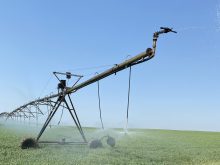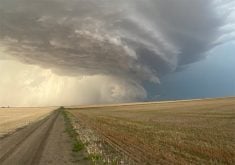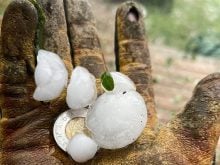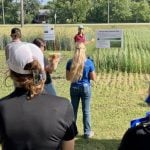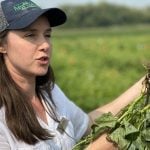In speeches this winter across Alberta, provincial agricultural entomologist Scott Meers was able to bring somewhat welcome news.
“For some of you, in specific areas, there will be challenges this year,” he told farmers attending Edmonton’s Farm Tech conference in early February.
However, the overall threat of insect pests in Alberta is down compared to many years. Prairie entomologists warn this year might have fewer large-scale insect pest threats, but under the right conditions damage could quickly reach the economic thresholds for control. A warm and open fall provided healthy habitat for many insects to complete a long season of reproduction, increasing the potential for infestations in 2009.
Read Also

Rented farmland jumps 3.4 million acres in Saskatchewan and Alberta
Farmland rented or leased in the two provinces went from 25.7 million acres in 2011 to 29.1 million in 2021, says Census of Agriculture data.
2008’s challenges
The cabbage seedpod weevil resulted in the greatest economic damage to Alberta in 2008.
Last year, extensive areas south of the Trans-Canada Highway were treated for the insect. North of the seedpod weevil’s treatment territory, wheat midge took over as the pest most controlled, however in many cases producers missed the spraying window, say agrologists.
Cabbage seedpod weevil
The cabbage seedpod weevil began colonizing southern Alberta in 1995 and spread steadily east ever since.
The pest is now in Saskatchewan and is expected to spread north into the Peace River district of Alberta and British Columbia over time, say entomologists from other provinces.
“We expect this pest to eventually reach across Western Canada’s canola growing regions,” said Scott Hartley of Saskatchewan Agriculture.
Meers said despite the predicted expansion, the insect is still only found in southern Alberta and southwestern Saskatchewan.
“There were a lot producers that controlled seedpod weevils in 2008 and high enough populations at (test) sites south of the Trans-Canada to warrant it,” he said.
While higher commodity prices did lower control thresholds, the populations in many cases would have warranted control even at lower prices, say researchers, including Hector Carcamo of Agriculture Canada in Lethbridge.
“Conditions last season were ideal for increases in the cabbage seedpod weevil this year. Cooler weather in August with moisture: if that was your experience on your farm, then you need to be out there scouting as the canola comes into flower,” he said during an agronomy update in Lethbridge at the end of January.
Bertha armyworm
Bertha armyworm wasn’t a threat during 2008 and there won’t likely be a problem in 2009.
Lygus
The cooler 2008 season should result in fewer lygus bugs in 2009, but there were large populations of adults recorded during the early flowering stage of canola in southern and central Alberta last year. Spraying of cabbage seedpod weevil may have resulted in fewer lygus in those fields. It appears that lygus adults can be found in the same sweep net samples used for cabbage seedpod weevil.
Flea beetles
An open fall and observed high populations of flea beetles during and after harvest are a concern for producers. Those who have seen the insects or traditionally have had problems with them should expand seed treatment to the higher level of coverage for 2009.
Root maggot
The root maggot has no chemical control and no surveys have determined the extent of the threat by this insect. Entomologists say it is present in the black soils of the Edmonton to Vegreville and Red Deer regions, especially where moisture was abundant.
Cereal leaf beetle
Now established in southern Alberta and southwestern Saskatchewan, the cereal leaf beetle isn’t considered a serious threat for 2009. However, its continued spread is a future concern for producers, Carcamo said.
“This pest has the potential to be a real problem for cereal production.”
Wheat stem sawfly
The wheat stem sawfly remains a serious pest threat in some areas of Alberta. The introduction of solid stem wheat varieties such as Lillian have reduced the damage, but the insect remains a serious threat in areas north of Lethbridge centred on Vulcan and west and south of Calgary to the foothills.
Meers said the rise in parasitism is helping producers with this pest and he hopes that this, combined with cultural control based on solid stem and alternative cereal crops, will begin to reduce the overall problem.
Orange wheat blossom midge
Wheat midge was a serious pest for Alberta and most of the Prairies in 2008, but there may be some relief for 2009, said Meers.
“But that is relative to last year. It’s still a problem and if you had them last year, you’d better be out scouting this year.”
“Farmers need to monitor this insect from the time when those wheat heads first become visible in the boot. When that boot splits, earlier than most think, and stay at the monitoring until mid flowering. I know it’s a pain, … but it’s necessary if you want an opportunity for control,” he said. “They have natural enemies and we have adjusted the (Alberta midge threat) map to reflect the level of parasitism.”
Pea leaf weevil
The northerly range of the pea leaf weevil in Alberta did not expand in 2008, nor the amount of damage this pest is creating, said Meers.
Based on fields where peas had greater than nine feeding notches per plant, there will be pockets of severe and moderate damage in Alberta, similar or worse than 2008. Pea leaf weevils tend to do well where conditions were cool and moist in the previous August, as they were in most of Alberta in 2008. The insect is expected to be a problem in Vulcan, Lethbridge, Taber, Warner and Cypress counties.
“If you have observed (the nine notches per plant) last season, then you should budget for Cruiser seed treatment this year,” said Meers.
Seed treatment has been effective in controlling damage.
Grasshopper
Grasshopper numbers are on the upswing in much of Western Canada, and Alberta will see elevated populations if conditions are dry and warm. Areas of southern and eastern Alberta and the Peace River district are at highest risk, said Meers.
“We had a great fall for grasshoppers. That creates the potential for problems if the conditions support them in the spring.”
Wireworm
Wireworm was a concern for growers in 2008 and will likely be a concern in 2009.
Alfalfa weevil
A problem pest for the past four seasons, the alfalfa weevil remains a concern for some forage producers.
Red clover casebearer
The Peace region is being hit by red clover casebearer larvae.
“Once you see this pest, there is no point in attempting a second crop in that field. In some cases it does significant damage in the first season,” Meers said.
Alfalfa blotch leaf miner
In the Brooks area, the alfalfa blotch leaf miner is well established. So are its parasites, which seem to have had some effect on the pest. For alfalfa forage producers, control generally isn’t pursued, but seed growers may opt for treatment.




